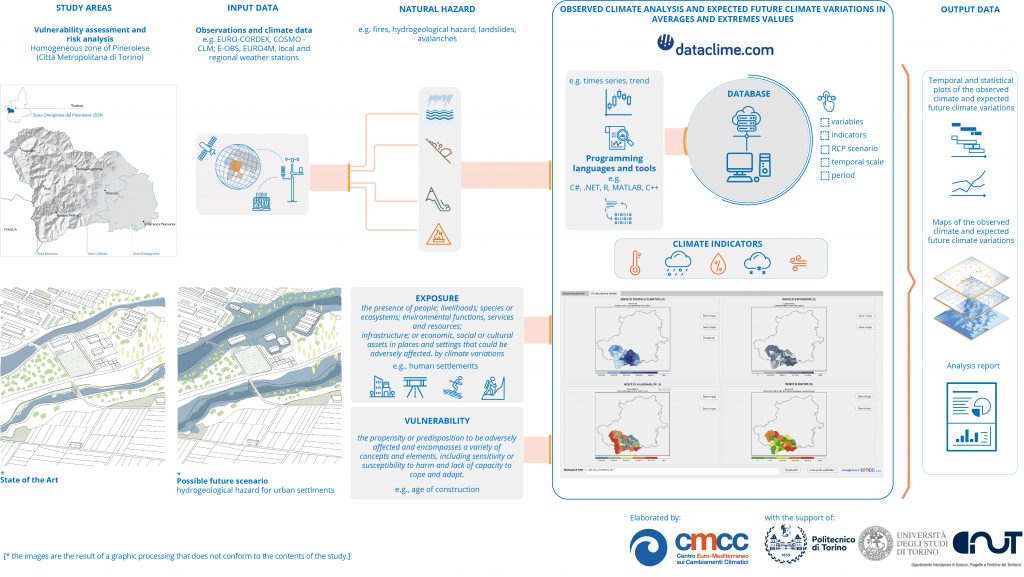Rysk analysis Metropolitan City of Turin
Goals
The objective of the activity was the development of vulnerability assessment and risk analysis methods for the effects of climate change at the local scale for the municipalities of the Metropolitan City of Turin in the Homogeneous Zone of Pinerolese. The activity was carried out on behalf of the Inter-University Department of Science, Project and Territorial Policies (DIST) of the Polytechnic of Turin within the European project Interreg – ALCOTRA “ARTACLIM – Adaptation and Resilience of the Alpine Territories in the face of climate change” (http://artaclim.eu/index.php/it/ ). The preliminary assessments on the risk analysis will support the technicians of the Metropolitan City of Turin and the local authorities of the Pinerolese territories, to undertake projects to increase the resilience of territories related to the impacts of climate change or for assessments preparatory to the development of sectoral plans.
Carried out activities
The carried out activities have focused on:
- the identification of climatic hazards through the selection of indicators relating to changes in the precipitation and temperature regime in relation to the analyzed sectors such as settlement systems, infrastructure, summer and winter tourism, agriculture, forests and biodiversity. Climate hazard indicators included hydrogeological hazards, floods, landslides, avalanches, fires (drought) and heat waves. The observed climate has been analysed through local weather data while the future expected climate anomalies due to climate change were considered through simulation with high resolution models. In particular, it has been used two different IPCC scenarios (RCP 4.5 ed 8.5) and it has been considered different future periods;
- the definition of the exposed samples according to the analyzed territory starting from the urban, socio-economic and natural systems considered within project (for example, the settlement system, infrastructures, winter and summer tourism, agriculture, forests and biodiversity;
- the identification of sensitivity and adaptive capacity indicators based on the selected exposed samples and on the availability of data and information.
- the calculation of potential risk levels showed through a IT platform developed during the project that can also be used by users, as a tool to support decision-making processes and urban and territorial planning.

Dataclime functionalities
Through the Dataclime platform, registered users are provided the opportunity to view and download all hazard maps (based on three different IPCC scenarios, two analyzed time periods, and 70 different hazard indicators related to precipitation, temperature, wind, and snow), exposure, vulnerability and risk based on the economic sector of interest (Summer Tourism, Winter Sports and Major Events, Eyewear Industry, and Electricity Distribution).
Reference:
https://papers.ssrn.com/sol3/papers.cfm?abstract_id=4080578
Website:
https://www.univiu.org/viu-life/news-archive/2161-climate-proofing-in-investments-and-spatial-planning
https://www.enelfoundation.org/topics/articles/2020/04/climate-proofing-in-investments-and-spatial-planning
https://www.enelx.com/content/dam/enel-found/navigant/cidD49862B0-4154-4171-BFE1-A9C3CCE0E1A5.pdf
https://corrierealpi.gelocal.it/belluno/cronaca/2020/08/07/news/resistere-ai-cambiamenti-climatici-belluno-con-vaia-ha-indicato-la-strada-1.39171834
https://www.enelfoundation.org/all-news/news/2021/10/assessing-disaster-risk-reduction-in-the-dolomites-area
Note:
*Climate indicators are synthetic parameters obtained from different atmospheric variables (temperature, precipitation) aimed at analyzing the main characteristics of the extreme atmospheric events with the greatest impact whose evolution in the future climate is to be studied (Reder, A. et al ., 2018). Climate indicators mainly describe the intensity and frequency of extreme events in terms of precipitation and temperature, and are useful for subsequent sector studies aimed at evaluating the main local impacts of climate change on which adaptation strategies are based

